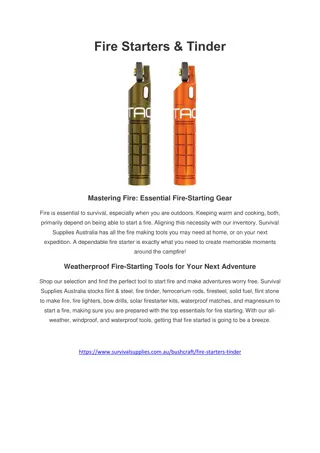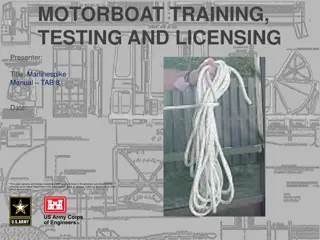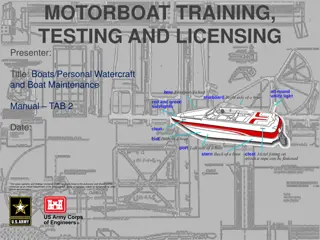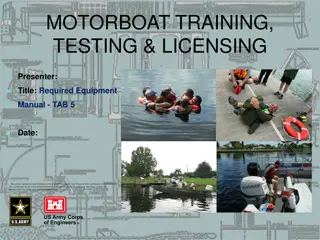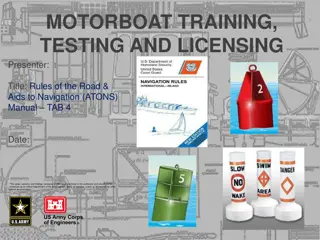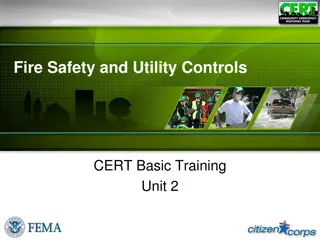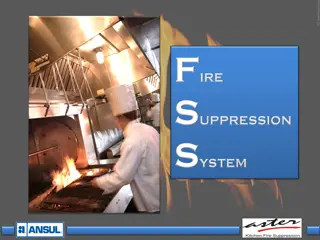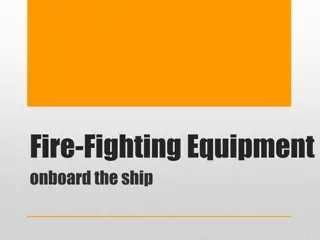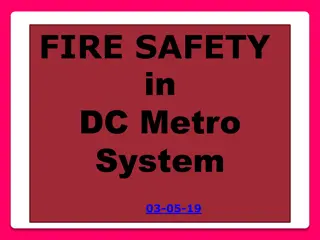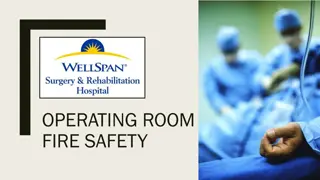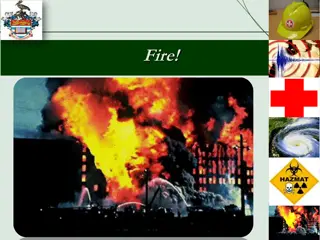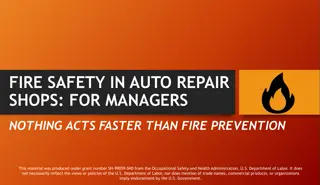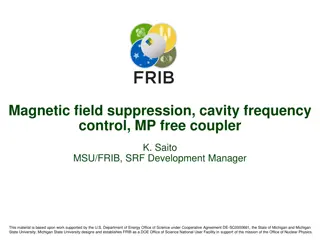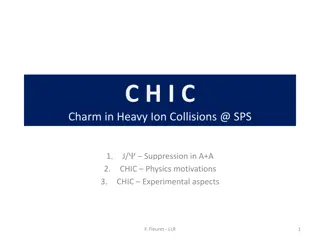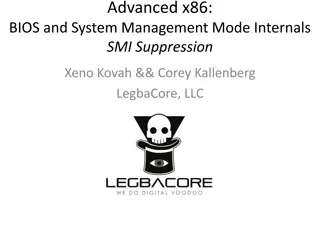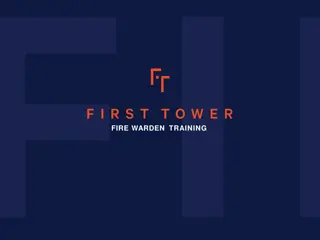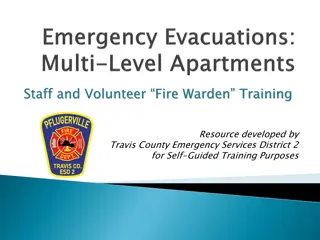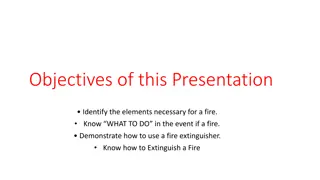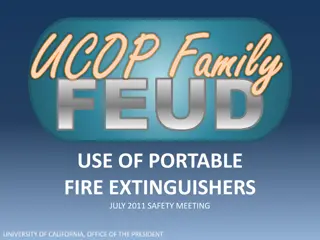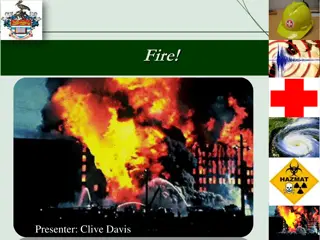Fire Suppression Training Manual for Motorboat Licensing
This manual covers essential information on fire suppression for motorboat training, testing, and licensing. It outlines fire classes, fuel sources, procedures for handling boat fires, legal requirements for fire extinguishers, and more. The manual also details the types of extinguishing agents, fire extinguisher requirements, and guidelines for mounting and maintaining extinguishers on boats. Additionally, it explains the types and quantities of fire extinguishers required based on the length of the vessel. The content emphasizes the importance of fire safety measures and compliance with USCG regulations.
- Fire Suppression Training
- Motorboat Licensing
- Fire Classes
- Extinguisher Requirements
- Boat Fire Safety
Download Presentation

Please find below an Image/Link to download the presentation.
The content on the website is provided AS IS for your information and personal use only. It may not be sold, licensed, or shared on other websites without obtaining consent from the author. Download presentation by click this link. If you encounter any issues during the download, it is possible that the publisher has removed the file from their server.
E N D
Presentation Transcript
MOTORBOAT TRAINING, TESTING & LICENSING Presenter: Title: Fire Suppression Manual TAB 6 Date: The views, opinions and findings contained in this report are those of the authors(s) and should not be construed as an official Department of the Army position, policy or decision, unless so designated by other official documentation.
2 2 FIRE SUPPRESSION Objectives: Understand the 4 fire classes and their fuel sources Learn the procedures if a fire erupts on your boat Understand the legal requirements for fire extinguishers Learn the USCG and COE fire extinguisher requirements for Class A and Class I boats Learn what P.A.S.S. stands for Learn the procedures for fueling your boat
3 3 How would you explain this on an ENG 3394?
4 4 What is required for a fire to burn?
5 5 Fire Class & Fire Extinguisher Type Type of Extinguishing Agent Fuel Source Class of Fire Ordinary combustibles (e.g. trash, wood, paper, cloth) Water; chemical foam; dry chemical* A Flammable liquids (e.g. oils, grease, tar, gasoline, paints, thinners) Carbon dioxide (CO2); halon**; dry chemical; aqueous film forming foam (AFFF) B Electricity (e.g. live electrical equipment) CO2; halon; dry chemical C Dry powder (suitable for the specific combustible metal involved) Combustible metals (e.g. magnesium, titanium) D
6 Fire Extinguisher Requirements 6 Marine Type USCG Approved Type & Size Symbols, USCG approval no. Extinguishers should be immediately accessible Mounted Correctly Maintained in a serviceable condition Inspect Regularly Seal is not broken or missing Gauges are in operable range
7 7 TYPE & QUANTITY of Fire Extinguishers Length of Vessel Without Fixed System ** With Fixed System * Less than 26 feet one B-I None 26 feet to less than 40 feet two B-I or one B-II one B-I 40 feet to less than 65 feet three B-I or one B-II and one B-I two B-I or one B- II *refers to a permanently installed system **USCG requirement EM 385-1-1, 19.F.03 a. - Corps vessels under 26 feet require one 1A:10BC
8 8 Fire Extinguisher Charge Indicators To check this style of extinguisher, depress the green button. If it is fully charged, the green button should pop back out immediately. On this style of fire extinguisher, the needle indicator should be in the "full" range.
9 9 What Does P . A . S . S . Stand For ?
10 10
11 11 Fueling Your Vessel: Before Fueling Secure vessel to the fueling dock All Passengers will Exit the Boat No smoking is permitted during fueling Ensure Fuel Lines, Connections, & Fuel Vents are OK Turn off anything that may cause a spark engine, fans Turn off fuel valves and extinguish all open flames Close all windows, ports, doors, and openings to prevent fumes from entering vessel Remove portable fuel tanks to fill Ensure fire extinguisher is in reach
12 Fueling Your Vessel: While Fueling 12 Keep the nozzle of the fuel-pump hose in solid contact with the tank opening to prevent producing a static spark Use caution and fill the tank slowly to avoid spilling fuel into the boat s bilge or into the water. Use an oil-absorbent pad to catch drips or spills. Never fill a tank to the brim leave room for fuel to expand
13 Fueling Your Vessel: After Fueling 13 Put the fill cap on tightly to prevent vapors from escaping Wipe up any spilled fuel and properly dispose of the used paper towels on shore Open all windows, ports, doors, and other openings If your boat is equipped with a power ventilation system (exhaust blower), turn it on for at least four minutes before starting your engine. This will eliminate fuel vapors in the bilge. Before starting the engine, sniff the bilge and engine compartments for fuel vapors. Continue ventilating until you cannot smell any fuel vapors. Start the engine and reload your passengers.
14 If Fire Erupts on YOUR Boat 14 If Underway, stop the boat Have everyone who is not wearing a PFD put one on Position the boat so that the fire is DOWNWIND If the fire is in an engine space, shut off the fuel supply Aim the fire extinguisher at the base of the flames, P.A.S.S. Never use water on a gasoline, oil, grease, or electrical fire Summon help with your VHF marine radio Abandon ship if necessary
15 15 REVIEW: What are the 4 classes of fires and their respective fuel sources? What does P.A.S.S. stand for? What are the three things that make up the Fire Triangle ? What are the steps to take if a fire breaks out on the boat? What is the USCG requirement for Class A & Class I boats? What is the COE requirement for Class A & Class I boats? Name three things to do before fueling. Name three things to do while fueling. Name three things to do after fueling. T/F A bungee makes a great fire extinguisher bracket. What is the USACE Fire Extinguisher Requirement for boats under 26 in length?



